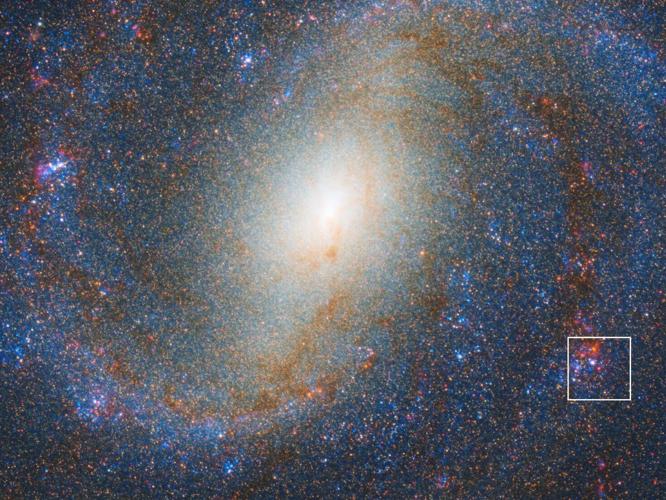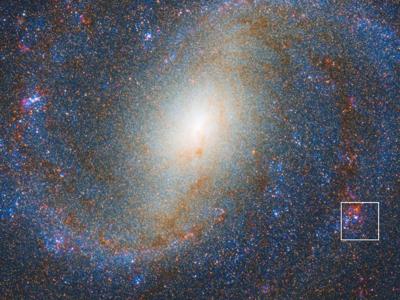
The main image at left shows a combined Webb and Hubble view of spiral galaxy NGC 1637, with the region of interest in the top right. The remaining three panels show a detailed view of a red supergiant star before and after it exploded. (NASA, ESA, CSA, STScI voa SWNS)
By Stephen Beech
The most detailed glimpse yet of a doomed star hidden in dust before it exploded has been captured by astronomers.
Using NASA’s James Webb Space Telescope (JWST), an international team identified a supernova’s source star, or progenitor, for the first time.
The observations - combined with archival images from the Hubble Space Telescope - revealed the explosion came from a massive red supergiant star, cloaked in an unexpected shroud of dust.
The discovery may help solve the decades-old mystery of why massive red supergiants rarely explode.
Theoretical models predict red supergiants should make up the majority of core-collapse supernovae.
The new study, published in The Astrophysical Journal Letters, shows those stars do explode but are simply hidden out of sight, within thick clouds of dust.
Astronomers can now finally pierce through the dust thanks to the JWST’s advanced capabilities.

The star is not visible in the Hubble image before the explosion, but appears in the Webb image. (NASA, ESA, CSA, STScI via SWNS)
Study leader Dr. Charlie Kilpatrick said: “For multiple decades, we have been trying to determine exactly what the explosions of red supergiant stars look like.
“Only now, with JWST, do we finally have the quality of data and infrared observations that allow us to say precisely the exact type of red supergiant that exploded and what its immediate environment looked like."
Dr. Kilpatrick, a research Assistant Professor at Northwestern University, added: "We’ve been waiting for this to happen - for a supernova to explode in a galaxy that JWST had already observed.
"We combined Hubble and JWST data sets to completely characterize this star for the first time.”
Astronomers first detected the supernova, dubbed SN2025pht, on June 29 this year.
Its light had travelled from a nearby galaxy called NGC 1637, located 40 million light-years away from Earth.
By comparing Hubble and JWST images of NGC 1637 from before and after the star’s explosion, the research team found SN2025pht’s progenitor star.
Dr. Kilpatrick said: "It was immediately striking - extremely bright and incredibly red."
Although the star shone about 100,000 times brighter than our sun, surrounding dust obscured much of the light.
The dusty veil was so thick that the star appeared more than 100 times dimmer in visible light than it would appear without the dust.
Because dust blocked out shorter, bluer wavelengths of light, the star also appeared surprisingly red.
Study co-author Aswin Suresh, a graduate student at Northwestern’s Weinberg College of Arts and Sciences, said: “It’s the reddest, dustiest red supergiant that we’ve seen explode as a supernova."

Hubble and Webb looks after the explosion. (NASA, ESA, CSA, STScI via SWNS)
He explained that massive stars in the late stages of their lives, red supergiants, are among the largest stars in the universe.
When their cores collapse, they explode as Type II supernovae, leaving behind either a neutron star or a black hole.
The most familiar example of a red supergiant is Betelguese, the bright reddish star in the shoulder of the constellation Orion.
Dr. Kilpatrick said: “SN2025pht is surprising because it appeared much redder than almost any other red supergiant we’ve seen explode as a supernova.
“That tells us that previous explosions might have been much more luminous than we thought because we didn’t have the same quality of infrared data that JWST can now provide.”
He says the deluge of dust could help explain why astronomers have struggled to find red supergiant progenitors.
Most massive stars that explode as supernovae are the brightest and most luminous objects in the sky.
They should be easy to spot before they explode, but that hasn’t been the case.
Astronomers suspect that the most massive ageing stars also might be the dustiest, making them hard to detect.
Dr. Kilpatrick said: “I’ve been arguing in favour of that interpretation, but even I didn’t expect to see such an extreme example as SN2025pht.
“It would explain why these more massive supergiants are missing because they tend to be dustier.”

A combined Webb and Hubble view of spiral galaxy NGC 1637. (NASA, ESA, CSA, STScI via SWNS)
He says the dust’s composition was also surprising as while red supergiants tend to produce oxygen-rich, silicate dust, this star’s dust appeared rich with carbon.
Dr. Kilpatrick says it suggests that powerful convection in the star’s final years may have dredged up carbon from deep inside, enriching its surface and altering the type of dust it produced.
He said: “The infrared wavelengths of our observations overlap with an important silicate dust feature that’s characteristic of some red supergiant spectra.
“This tells us that the wind was very rich in carbon and less rich in oxygen, which also was somewhat surprising for a red supergiant of this mass.”
He said the new study marks the first time astronomers have used JWST to directly identify a supernova progenitor star, opening the door to many more discoveries.
The team is now searching for similar red supergiants that may explode as supernovae in the future.
Dr. Kilpatrick says observations by NASA’s in-development Nancy Grace Roman Space Telescope may help the search.
He added: “With the launch of JWST and the upcoming Roman launch, this is an exciting time to study massive stars and supernova progenitors.
“The quality of data and new findings we will make will exceed anything observed in the past 30 years.”


























(0) comments
Welcome to the discussion.
Log In
Keep it Clean. Please avoid obscene, vulgar, lewd, racist or sexually-oriented language.
PLEASE TURN OFF YOUR CAPS LOCK.
Don't Threaten. Threats of harming another person will not be tolerated.
Be Truthful. Don't knowingly lie about anyone or anything.
Be Nice. No racism, sexism or any sort of -ism that is degrading to another person.
Be Proactive. Use the 'Report' link on each comment to let us know of abusive posts.
Share with Us. We'd love to hear eyewitness accounts, the history behind an article.